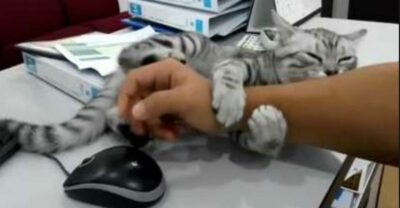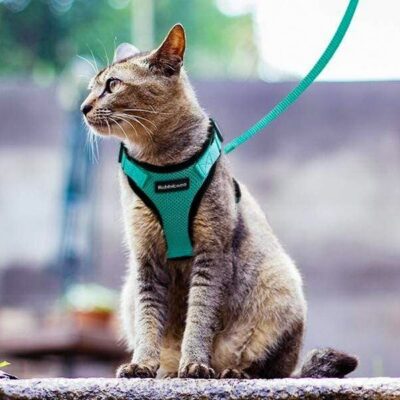Can you train a cat? Many people will say, “Sure, you can train a dog, but a cat? They are too independent. You won’t be able to convince them to do as you wish.”
Wrong. It’s an exercise in patience, but, yes, you can train a cat. He’s a very intelligent animal, and deserves to be recognized as such. Now what you need to decide is what to teach kitty. Are there certain skills you think he needs, or special tricks you’d like him to learn to do? Make your list.
You might consider clicker training, as it gives you a way to communicate with your cat that can lead to good results. An example: If kitty has learned to come to the sound of the clicker, then if she escapes outside, the clicker might be a great way to call her back.
Kittens Need Training In Socialization
If your cat is still a kitten, so much the better. Teach the youngster to be comfortable interacting with humans. Kittens tend to play using teeth and claws, as they interact with their siblings in this way. It’s how they learn about fighting and hunting.
They need to learn that it is not appropriate to bite or scratch hands or feet. If you don’t discourage this behavior when they are very young, they won’t realize it’s not a good way to interact with their human family. When they get older, they won’t break these habits easily.

I speak from experience here. Mocha, my new cat, is 4 1/2 years old. He was never socialized, so he thinks that the best way to interact with me is to attack — all in the course of play, or course, but as a grown cat, he’s ‘way too rough. When I received a serious bite, I realized he had to learn new behavior.
Now, if he starts the aggressive play, I simply walk away. That works in most cases. However, sometimes he starts that behavior as a way of resisting what I’m doing. Example: He does not like to be brushed, but he’s semi-longhaired and needs the grooming.
I wear gloves. I also use a lickable treat. He gets a little of that first; then, when I start brushing, if he gets aggressive, I stop and give him a bit more treat. Then he’ll tolerate the grooming for a bit. If he gets too wound up by the whole thing, I just stop and come back later.
If he’d been taught as a kitten not to scratch and bite every chance he got, he’d certainly be much easier to train now.
If He Exhibits Bad Behavior, Do Not Punish

Punishing a cat just causes resentment, erodes trust, and can make kitty afraid of you. Instead, if he’s doing something he shouldn’t, distract him with something else…Sometimes a loud noise will do the trick. Sometimes diverting his attention with a toy will work.
Try to find a way to distract him without using the word “no”, as he may get confused if this word is used too often. Hold it back as the “final trick” in your arsenal.
Make Training Sessions Short
Keep your training sessions short so kitty will be more apt to stay focused on what you are doing. You can train frequently, however, so kitty will not forget his lessons. Remember to remain calm, patient, and persistent. Don’t give up on kitty, as it may take a while for him to catch on.
Training Should Focus On One Behavior At A Time
Don’t confuse the issue. Train for one behavior during this session, and save the others for another time. In this way, you can be sure kitty has mastered one behavior before you move on to another.
If she loses interest, don’t force the issue, as she will only rebel at not being able to do as she pleases. Come back and try it later.
Find An Outstanding Reward To Use For Good Behavior
Of course, verbal awards become one way to let your kitty know she’s done well and that you are proud of her. Be sure to bestow such “attagirls” often, to encourage your cat. She needs to know when you are pleased with her.

Do find an edible reward that the cat finds irresistible. Then, reward this yummy enticement regularly when kitty is responding in the proper way.
I’ve mentioned using a lickable treat when grooming Mocha. I believe it would also be suitable as a training reward for other accomplishments, just because the cat loves that treat so much. Find something your kitty wants, and you can teach her how she can get more of it.
Getting Other Family Members Involved
If you have other family members or regular visitors, get them involved in training, too, if possible. If, for example, if someone in the family catches the cat scratching the furniture, that person needs to know what methods you are using to discourage this behavior.
Then, they can follow through with the same methods so the cat will understand his error.
Does Kitty Make Proper Use Of The Litter Box?
To make sure kitty uses the litter box exclusively for bathroom business, follow these suggestions
- Place it in a convenient and quiet location
- Make sure the cat remembers the box’s location
- High sides are helpful, as these contain the litter better
- Clean the box daily — I recommend twice a day at least
- When litter gets low, dump it and wash out the box
- Do not use a covered box (why would a cat want to be shut in there with the smell?)
I’ve had experience with that last point. My last cat, Pogo, ended up in the shelter because he would not use his covered litter box. When I brought him home, I gave him a high-sided uncovered box, cleaned it regularly, and never had a problem with “accidents.”
Scratching Is Necessary If You’re A Cat
Cats need to scratch to keep their nails healthy. Therefore, if you don’t want them to scratch on inappropriate objects, make sure to provide sufficient suitable places to sharpen the claws. Get at least two scratching posts.

I’d recommend getting a sisal one or two and also a cardboard scratcher. You can sprinkle both with catnip to lure the cat into using them. If the cat still uses a spot where you don’t want them to scratch, make a loud, obnoxious noise to get them to stop. Then redirect them to the proper place.
No, don’t get the cat declawed. Would you want your fingers cut off at the first joint? Well, your cat doesn’t want that, either…it causes great pain and changes the way they walk. It can lead to psychological trauma, which you don’t want or need.
Instead, keep the claws trimmed. I opt for the vet with Mocha, as he is a polydactyl, so has extra toes, and he does not want them messed with. The vet puts him in a body suit and pulls one paw out at a time to trim the nails. We get through the experience with minimum trauma this way.
Does Your Cat Come When Called?
You can use treats to reward your cat when he comes when you call his name. Start with a short distance and gradually increase, giving kitty a treat each time he responds when you call him. Then, he will make the connection eventually and respond just to his name.
It all depends on the cat. Mocha knows his name, now, very well. He comes when I call him — sometimes. He must ask himself, “What’s in it for me?” and bases his decision to come or not based on the answer to that question. I re-establish name training periodically to try to get the message across that he needs to respond.
Meanwhile, I know he knows that name, but sometimes he is just too involved in his own thing. Just be patient and consistent in your training.
Teach Your Cat To Sit

Show your cat that you have a delectable treat in your hand. Then hold your hand a few inches over kitty’s head. He will tend to sit so he can look at your hand better. Remember to say “sit” when you do this move.
If kitty wants to get up on two paws, remove the food. Try the same thing again when he’s back on all fours. Try again, holding the treat over his head. Once he sits, give him the treat and tell him how smart and wonderful he is.
Eventually kitty will respond by sitting if you just give the command and hold your hand over his head, even if there is no treat there.
Teach Kitty To Walk On A Leash
I’ve written an earlier post about leash training a cat, so you might want to check out this link. Meanwhile, here’s a list of the steps needed to accomplish that training:
- It’s important to get the cat used to the harness he needs to wear. At first, just leave it out so he can look it over.
- Next, put the harness on kitty just before mealtime. Then the leash has a positive association.
- Once kitty is comfortable with the harness, attach the leash. Then, set it down and walk to the end of it. Now, if he will follow when you have the leash in your hand, you’ve made real progress.
- Rinse and repeat, until kitty is comfortable with the process, and will walk with you when you hold the leash. Then you can try taking him outside.

My experience with Mocha and harness and leash has not been ideal. I got him a vest, and at the time, had a housemate living here. It took both of us to get that vest on the cat. When my housemate left, I knew I couldn’t get the vest on the cat by myself.
Oh, he was fine once the vest was on. He really enjoyed his outdoor excursions. I decided to get a very simple harness for him if I had to get it on him by myself. Oh, yes, it was still a struggle, but we could manage it. However, it was a struggle every time we tried it.
Therefore, I switched to using just a collar and attaching the leash to it. Not a perfect solution, as the cat could escape if he tried hard enough. However, he does quite well with just a collar. I think I’ll try the harness again this coming spring. For now, he’s staying in, because weather isn’t nice.
Your Kitty Can Learn To Do A High Five
Teaching a high five is similar to teaching a cat to sit. Put a treat in your hand and close your fist. Put the fist in front of your cat, and as soon as his paw moves toward your hand, use a clicker if he understands them or simply praise; then give him the treat.
Once the cat understands that he gets a reward every time his paw touches your hand, he’s well on the way. Gradually lift your hand higher and higher, and every time he touches your hand with his paw, give him a treat. Don’t forget to say “high five” every time you repeat the process.

Soon the cat will give you a high five whenever you say the words.
You might say my cat, Carlos, taught himself the high five. On Kodiak, my Spruce Island caretaker, Greg, was visiting. I had the cat’s food ready, and he reached up a paw for it. Greg said, “he’s trying to do a high five.”
Well, it didn’t take much to hold up the food, say “high five,” and have the cat reaching for it. I’d put my hand next to the bowl and he’d hit my hand with his paw. So cute!
It Could Be The Start Of Something Big
There you have it — a bit of information on training your kitty. Once you’ve found that the cat can learn to respond to your verbal commands, you may want to teach him other tricks and skills. If you keep the lessons short and fun, kitty will enjoy interacting with you, and will bond closer.
If you’d like to see just how well cats can be trained, click on the video in the right sidebar of this website called “The Savitsky Cats.” You will truly be amazed.
References I used for this post:
thehonestkitchen.com/blogs/pet-tips-training/how-to-train-a-cat purina.com/articles/cat/training/how-to-train-a-cat thesprucepets.com/top-ways-to-train-your-cat-5525834 hillspet.com/cat-care/training/cat-training-the-easy-way basepaws.com/blogs/news/how-to-train-a-cat


Great article. We’re down to 3 outside cats and they only know one thing – eat! They never miss a meal
Well, I am guessing they have that one figured out to the nth degree.